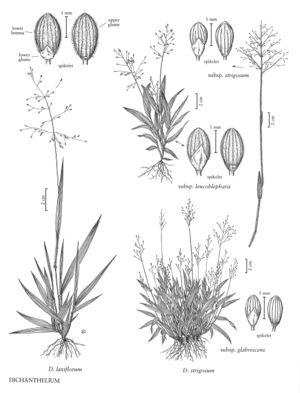Difference between revisions of "Dichanthelium strigosum"
FNA>Volume Importer |
imported>Volume Importer |
||
| (4 intermediate revisions by 2 users not shown) | |||
| Line 7: | Line 7: | ||
|synonyms={{Treatment/ID/Synonym | |synonyms={{Treatment/ID/Synonym | ||
|name=Panicum strigosum | |name=Panicum strigosum | ||
| − | |authority= | + | |authority= |
| + | |rank=species | ||
}} | }} | ||
|hierarchy=Poaceae;Poaceae subfam. Panicoideae;Poaceae tribe Paniceae;Dichanthelium;Dichanthelium sect. Strigosa;Dichanthelium strigosum | |hierarchy=Poaceae;Poaceae subfam. Panicoideae;Poaceae tribe Paniceae;Dichanthelium;Dichanthelium sect. Strigosa;Dichanthelium strigosum | ||
| Line 20: | Line 21: | ||
-->{{Treatment/Body | -->{{Treatment/Body | ||
|distribution=Puerto Rico;Va.;Ga.;Tex.;La.;Ala.;Tenn.;N.C.;S.C.;Miss.;Fla. | |distribution=Puerto Rico;Va.;Ga.;Tex.;La.;Ala.;Tenn.;N.C.;S.C.;Miss.;Fla. | ||
| − | |discussion=<p>Dichanthelium strigosum extends from the southeastern Flora region south into Mexico, the Caribbean, and into northern South America.</p><!-- | + | |discussion=<p><i>Dichanthelium strigosum</i> extends from the southeastern Flora region south into Mexico, the Caribbean, and into northern South America.</p><!-- |
--><p>The primary panicles are briefly open-pollinated in April or May; the secondary panicles, which are produced from May through November, are cleistogamous. The three subspecies are mostly sympatric and sometimes grow together, with occasional intergradation.</p> | --><p>The primary panicles are briefly open-pollinated in April or May; the secondary panicles, which are produced from May through November, are cleistogamous. The three subspecies are mostly sympatric and sometimes grow together, with occasional intergradation.</p> | ||
|tables= | |tables= | ||
| Line 52: | Line 53: | ||
-->{{#Taxon: | -->{{#Taxon: | ||
name=Dichanthelium strigosum | name=Dichanthelium strigosum | ||
| − | |||
|authority=(Muhl. ex Elliott) Freckmann | |authority=(Muhl. ex Elliott) Freckmann | ||
|rank=species | |rank=species | ||
| Line 59: | Line 59: | ||
|basionyms= | |basionyms= | ||
|family=Poaceae | |family=Poaceae | ||
| − | |illustrator=Linda A. Vorobik | + | |illustrator=Linda A. Vorobik;Hana Pazdírková |
| + | |illustration copyright=Utah State University | ||
|distribution=Puerto Rico;Va.;Ga.;Tex.;La.;Ala.;Tenn.;N.C.;S.C.;Miss.;Fla. | |distribution=Puerto Rico;Va.;Ga.;Tex.;La.;Ala.;Tenn.;N.C.;S.C.;Miss.;Fla. | ||
|reference=None | |reference=None | ||
| Line 65: | Line 66: | ||
|publication year= | |publication year= | ||
|special status= | |special status= | ||
| − | |source xml=https:// | + | |source xml=https://bitbucket.org/aafc-mbb/fna-data-curation/src/200273ad09963decb8fc72550212de541d86569d/coarse_grained_fna_xml/V25/V25_1212.xml |
|subfamily=Poaceae subfam. Panicoideae | |subfamily=Poaceae subfam. Panicoideae | ||
|tribe=Poaceae tribe Paniceae | |tribe=Poaceae tribe Paniceae | ||
Latest revision as of 17:56, 11 May 2021
Plants densely cespitose. Basal rosettes poorly differentiated; blades 1-5 cm, lanceolate, grading into the cauline blades. Culms 5-45 cm, slender, erect or spreading; from a dense tuft of predominantly basal leaves, lower internodes short, upper 3-5 internodes elongate; nodes glabrous or bearded; internodes glabrous or pilose; fall phase with spreading culms and branches arising from near the bases forming a dense, flat tuft. Cauline leaves 2-4; lower cauline sheaths longer than the internodes, mostly glabrous or pilose with ascending hairs, margins finely ciliate; ligules 0.2-2 mm, at low magnification appearing to be membranous and ciliate, at high magnification evidently of hairs that are coherent at the base; blades 1.5-6 cm long, 3-8 mm wide, lanceolate, glabrous or softly pilose, margins with prominent papillose-based cilia, at least basally. Primary panicles short- to long-exserted; rachises and branches often pilose. Spikelets 1.1-2.1 mm, obovoid to broadly ellipsoid, glabrous or pubescent, hairs not papillose-based. Lower glumes 1/3 - 1/2 as long as the spikelets, acute to obtuse; upper florets 0.8-1.7 mm, ellipsoid, subacute.
Distribution
Puerto Rico, Va., Ga., Tex., La., Ala., Tenn., N.C., S.C., Miss., Fla.
Discussion
Dichanthelium strigosum extends from the southeastern Flora region south into Mexico, the Caribbean, and into northern South America.
The primary panicles are briefly open-pollinated in April or May; the secondary panicles, which are produced from May through November, are cleistogamous. The three subspecies are mostly sympatric and sometimes grow together, with occasional intergradation.
Selected References
None.
Lower Taxa
Key
| 1 | Spikelets pubescent, broadly ellipsoid, 1.6-2.1 mm long; lower glumes about 1/2 as long as the spikelets; blades glabrous | Dichanthelium strigosum subsp. leucoblepharis |
| 1 | Spikelets glabrous, obovoid, 1.1-1.8 mm long; lower glumes about 1/3 as long as the spikelets; blades pilose or glabrous. | > 2 |
| 2 | Blades pilose; spikelets 1.1-1.6 mm long | Dichanthelium strigosum subsp. strigosum |
| 2 | Blades glabrous or sparsely pilose near the base; spikelets 1.4-1.8 mm long | Dichanthelium strigosum subsp. glabrescens |
